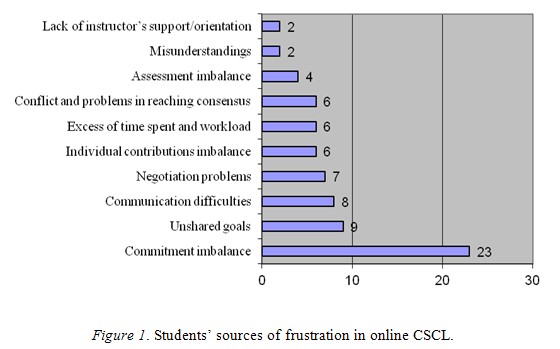Let’s start this post by mentioning that it was at this point into the ONL course where I realized that our learning subjects where mirroring our learning experiences. From this point on it became self-evident that the scenarios where just a verbalization of what was happening with us the learners at all times. PBL 11 from ONL191 is my own Personal Learning Networks (PLN)
OK, so my point is that we can analyse this chapters and the following ones with our own experiences. Let’s start by answering the question: Are Online Learners Frustrated with Collaborative Learning Experiences? In their work Neus Capdeferro and Margarida Romero find the following causes for frustration for computer-supported collaborative learning (CSCL)
This is an interesting topic to discuss as this is partially where I think the university is moving towards with the replacement of Live@Lund by the new canvas tool. And one could argue that although ONL is not perhaps fully CSCL, it definitively shares some of its sources of frustration.
 Taken from Capdeferro, N. & Romero, M. (2012).
Taken from Capdeferro, N. & Romero, M. (2012).
from the figure, it is cleat that by far commitment imbalance is the greater of the causes by almost three times the second one, Unshared Goals. This can be place side by side with out current learning process. In our PNL (PBL 11) we have slightly different goals and depending on the week different imbalances of commitment. I felt that the online meetings worked in a similar way as deadlines as people were forced to attend. Unfortunately I think we didn’t succeed at using the FISh method. We did a lot of sharing but it was rather frequent that only one person had read the material, watched the videos or even read the scenario. In the end things worked out as we did a lot of sharing but the imbalance was clear. I think we changed one another, week by week, from active learners to “witness learners” [ Beaudoin, M. (2003). Learning or lurking? Tracking the ‘invisible’ online student.]. In the study Beaudoin states many differences on why some metrics are not really good for measuring the engagement of students. It is almost anecdotal as they were only 24 students with mixed answers. A more detailed statistical study should be done. Maybe canvas can provide more insight into this as more and more Swedish universities use the system.
So how do we fix this? Jane E. Brindley and Christine Walti suggest in their paper Creating Effective Collaborative Learning Groups in an Online Environment the following:
Access to education should not mean merely access to content (which is readily available without formal enrollment with an educational provider); rather, it should mean access to a rich learning environment that provides opportunity for interaction and connectedness
So, it comes to no surprise that just as learning is not the same as memorizing facts, education is not just the access to knowledge. “The challenge is to sustain social presence while creating cognitive presence” Garrison, D. (2006). Online collaboration principles. They do so by using the community of inquiry model, and in this context and for the purpose of the Topic in question community is they key word. Not only we need to understand what our community does for us but we also need to participate of it.
Creating and sustaining this community is framed by the three core elements of a community of inquiry: social presence, cognitive presence, and teaching presence. Social presence reflects the ability to connect with members of a community of learners on a personal level. Cognitive presence is the process of constructing meaning through collaborative inquiry. Finally, teaching presence is the crucial integrating force that structures and leads the educational process in a constructive, collaborative and sustained manner. However, it is at the intersection of these three elements that a community of inquiry is created and a collaborative constructivist learning experience is achieved.
Let’s have a look at those core elements applied to ONL191 in particular PBL 11:
- social presence:
- The zoom conferences allowed this. Seeing people from different countries come together having a conversation “eye-to-eye“.
- cognitive presence:
- Again, you can pin this partly at the discussion during our zoom meetings. I guess this was supposed to happen while putting together the FISh document. As I said before. I think we were not particularly good at doing this
- teaching presence:
- This part I think was achieved with the work submissions to the entire PBL community and partly with this blogs, assuming people wrote them on time

So, signing up for a course introduces people into a learning group but I think it is the interaction through different tools like zoom and with the help of the facilitators when it becomes a community and from it a Personal Learning Network can emerge.